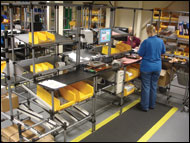 The ability to adapt and modify a process to introduce improvement is at the heart of lean manufacturing. Many businesses have been tempted to replace existing handling, storage and workstation installations with more dynamic facilities as part of their programme. Modular systems such as Lean Tek from the Tube & Bracket Company offer flexibility and adaptability required by lean but manufacturers will only realise long-lasting benefits if they see the changes they make as a starting point and not an end in itself.
The ability to adapt and modify a process to introduce improvement is at the heart of lean manufacturing. Many businesses have been tempted to replace existing handling, storage and workstation installations with more dynamic facilities as part of their programme. Modular systems such as Lean Tek from the Tube & Bracket Company offer flexibility and adaptability required by lean but manufacturers will only realise long-lasting benefits if they see the changes they make as a starting point and not an end in itself.
Lean manufacturing relies on the ability to change processes at any time to deliver continuous performance improvement. Traditional production environments have tended to rely too heavily on fabricated or big-budget equipment that is difficult and expensive to adapt or replace once it has been installed. Designs are typically agreed at the start of a project and there is little or no flexibility once everything is in place.
Modular systems, on the other hand, allow much more flexibility during the design and implementation stages. Handling, storage and workstation facilities are created using coated steel pipes, joints and accessories such as roller beds and wheels that allow an infinite range of potential configurations, shapes and sizes. Equipment can be optimised for the handling requirement, available space and best possible ergonomics to reduce or eliminate related space, movements and distances to maximise efficiency and productivity. Where many manufacturing businesses fall down is in not realising that there is always room for improvement, no matter how well designed the installation, and that changes can and should be made as often as needed.
The beauty of the modular systems is that they are designed to support change. Components are inexpensive, interchangeable and reusable and modifications can be made quickly and easily using basic tools in response to evolving production requirements. Adapting the layout of a workstation, repositioning some live storage or devising a new cart or trolley to handle unusually shaped components are just some of the changes that can be made to meet new requirements or deliver incremental performance improvement.
Moving to lean demands that production engineers are more analytical of the ongoing process. With traditional production environments a lot of effort is placed in the design because later modifications are difficult and expensive. With modular systems, the initial design is still important but later changes are much easier to make. For production engineers this can mean a switch in emphasis from process design to process improvement.
The real benefits of using modular systems to support lean manufacturing are often most evident in the live production environment. Engineers can improve the layout and ergonomics of the working area to ensure tools, components and sub-assemblies always remain within easy reach. This could, for example, reduce the number of picking tasks or the distances moved to place or retrieve items. Although seemingly trivial, removing or eliminating some of these tasks can lead to significant improvements in productivity. Even the height of the person working at a particular workstation can affect the precise optimum position of tools and components. Sometimes the potential improvement only becomes apparent when production is under way. Alterations may also be beneficial if something changes in the production environment such as the introduction of a different component or tool.
Production operatives are very good at spotting room for improvement in their own working environment. Many of the most successful implementations of lean manufacturing involve production staff collaborating with engineers to identify and implement change on the shop floor.
Another major area where introducing lean can help make significant improvements is with stock control. Items should only be brought into the production area when they are needed and taken away as soon as possible after the work has been completed. In lean plants the aim is typically to reduce inventory levels to a minimum without affecting the ability for continuous material flow. This often involves delivering items in and out of production areas using live storage facilities or bespoke carts and trolleys. Replenishment and collection tasks are carried out frequently and on-demand to ensure an undisrupted flow of materials. In both cases the storage equipment can be configured to the specific handling requirement and built to optimise the use of available space, not too much and not too little. In many instances this can free space on the shop floor that can then be used for additional value-adding processes. The amount of inventory tied up as “work in progress” is generally also minimised which releases cash for use elsewhere in the business.
The ability to introduce change whenever improvements are possible should allow production engineers to approach their tasks with a totally new way. Although they will still need to make careful plans for the initial installations there is no need for this to be the end. Instead, it is simply the starting point on a journey of continuous improvement that can be implemented in part with modular storage, handling and workstation facilities.
The Tube & Bracket Company Limited
Tel: 01295 277791
Email: sales@tubeandbracket.com
www.tubeandbracket.com





Comments are closed.